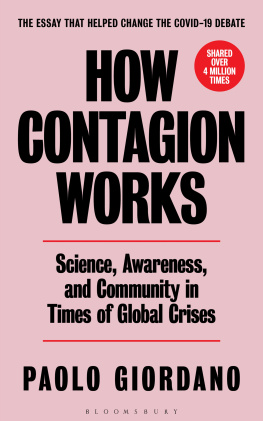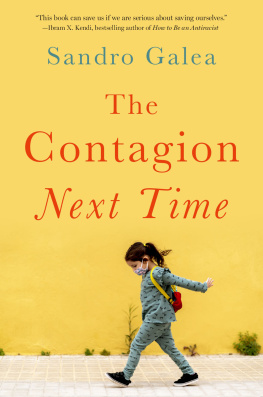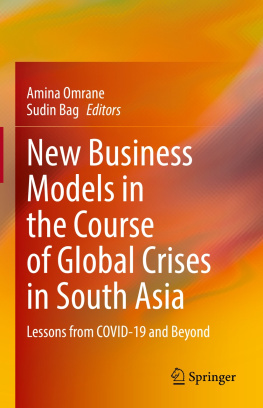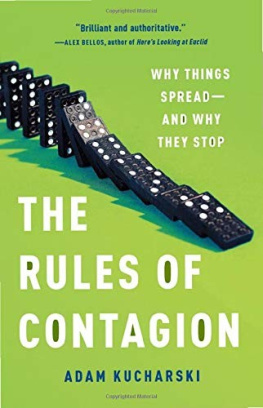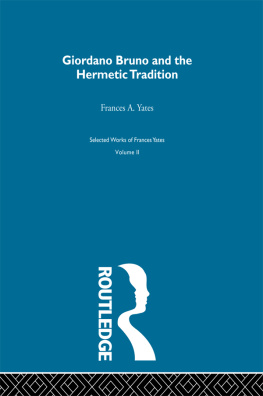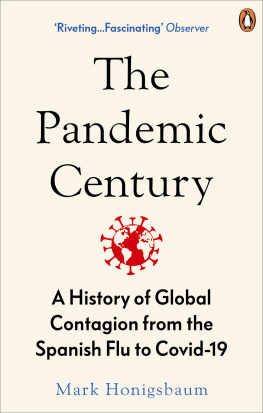Contents
Guide
How Contagion Works
Science, Awareness, and Community in Times of Global CrisesThe Essay That Helped Change the Covid-19 Debate
Paolo Giordano
Translated from the Italian by Alex Valente
Contents
The Covid-19 epidemic is set to be the most significant health emergency of our time. Not the first, not the last, maybe not even the most horrific. Most likely in the end the death toll wont be any higher than other illnesses and yet, three months since its debut, it has reached its first milestone: SARS-CoV-2 is the first virus to spread this quickly on a global scale. Many others similar in nature, such as its predecessor SARS-CoV, have been quickly dealt with. Some, such as HIV, have been hiding in the shadows for years. SARS-CoV-2 had more gumption. And its boldness has revealed something we had long known but had been unable to measure with precision until now: the multiple levels and layers that connect us to each other, everywhere, and the complexity of the world we inhabit its social, political, and financial motives and its interpersonal and psychological structures, too.
Im writing this on a rare February 29, a Saturday of this leap year. The confirmed global cases of infection have surpassed the 85,000 threshold almost 80,000 in China alone and the death toll is around 3,000. These numbers have been my silent companions for the past month. Even now, the Johns Hopkins University interactive map is open in front of me. The areas of infection are identified by red circles in stark contrast against the gray background. Perhaps another choice of colors might have been better, less alarming, but we all know how this works: viruses are red, emergencies are red. China and Southeast Asia have disappeared beneath a giant red stain, but the entire world is pockmarked, and the rash is bound to get worse.
Italy, much to everyones surprise, has also found itself leading the race in this anxious competition. This has happened entirely by chance: in a few days suddenly, unexpectedly other countries could find themselves in even worse conditions. At this moment of crisis, the expression in Italy has no meaning: there are no more borders, regions, neighborhoods. The nature of what were going through is above identities and cultures. The epidemic is the ultimate proof of how our world has become globalized, interconnected, inextricable.
I know all this and yet, as I watch the red disc growing over Italy, I cant help but feel troubled by it, as we all are. My bookings for the next few days have been canceled because of the containment procedures some I called off personally and I found myself surrounded by an unexpected emptiness. A predicament shared by many: were living through a suspension of daily activities and routines, a pause in the usual rhythm of our lives like one of those songs where the drums stop abruptly and the music seems to expand in the emptiness left behind. Schools are closed, very few planes are moving across the sky, solitary footsteps echo in museum corridors. Everywhere is shrouded in more silence than usual.
I decided to make use of this void by writing. Writing can sometimes be an anchor that helps us stay grounded and hold back fear. But there is also another reason: I dont want to lose what the epidemic is revealing about ourselves. Once the emergency is over, any temporary awareness will also disappear that is the nature of illnesses.
As you read these pages, the situation will have changed. The numbers will be different, the epidemic will have spread farther: it will either have reached every corner of the globe, or it will have been stopped, but some of the reflections emerging from the contagion will still apply. Because what is happening isnt a random accident or a scourge. And its nothing new, either: it has happened before, and it will happen again.
I remember afternoons back in my first years of high school, when Id spend all my time simplifying expressions. Id copy a long line of symbols out of the textbook, then reduce it to a concise, understandable result: 0, -, a2. The world outside of the window would darken and the landscape would give way to the reflection of my face lit up by my desk lamp. Those were peaceful afternoons. Bubbles of order at an age when everything inside and outside of me especially inside seemed to tend towards chaos.
Long before writing, math was my trick to keep anxiety at bay. To this day, there are mornings when I wake up and I improvise calculations and numeric sequences; its usually a symptom that somethings wrong. I suppose all of this makes me a nerd and I dont mind. Plus, these days it seems that math isnt just a nerdy pastime after all, but rather the indispensable tool in understanding what is happening to us and keeping our irrational tendencies in check.
Epidemics are mathematical emergencies first and foremost. Because math isnt the science of numbers not really its the science of relations: it describes the bonds and the exchanges between different entities, regardless of what these entities might be made of, abstracting them into letters, functions, vectors, points, and planes.
The contagion is an infection of our relations.
We could see it gathering like dark storm clouds on the horizon, but China is far away and anyway, stuff like that would never happen here.
When the contagion arrived, in full force, it left us all stunned.
To find a way through the disbelief I turned to math, starting with the SIR model, the invisible bone structure of every epidemic.
A notable distinction: SARS-CoV-2 is the virus, Covid-19 the illness. They have unfriendly, impersonal names, maybe chosen to limit their emotional impact, but they are more precise than the popular coronavirus. So I will be using them instead. To simplify even further, and to avoid misunderstandings with the 2003 SARS contagion, Ill be abbreviating SARS-CoV-2 to CoV-2 throughout.
CoV-2 is the most elementary form of life we know. To understand its actions, we need to inhabit its dumb intelligence, look at it like it looks at us. And remember that CoV-2 doesnt care about us, our age, gender, nationality, personal preferences. The entire human species, in the eyes of the virus, falls into one of three categories: the Susceptible, those it can still infect; the Infected, those it already has; the Recovered, those it can no longer infect.
Susceptible, Infected, Recovered: SIR.
According to the contagion map pulsating on my screen, the Infected around the world are currently 40,000; the Recovered, a little higher. The group we need to keep an eye on, however, is the third, the one that is never reported.
The Susceptible to CoV-2, the humans that can still contract the virus, are 7.5 billion, give or take a handful.
Lets pretend there are 7.5 billion marbles, representing the worlds population. We are susceptible and perfectly still, when suddenly an infected marble rolls at full speed against us. That infected marble is patient zero and hits two more marbles before coming to a halt. The latter two bounce off and hit two more each. And so on.
And again.
And again.
Thats how contagion starts, as a chain reaction. During its first phase it grows in a way that mathematicians call exponential: more and more people are infected, with increasing speed. The speed depends on a number, the hidden heart of each epidemic: its noted with the symbol

